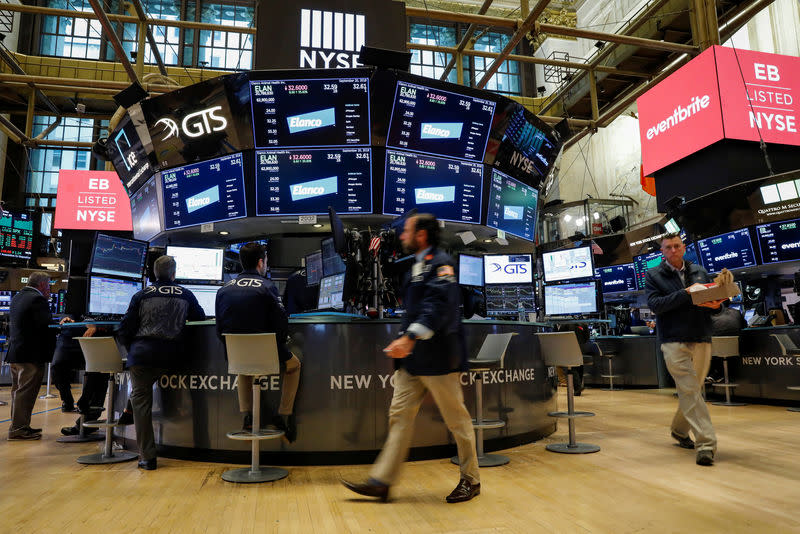One immediate risk to stocks that has nothing to do with the midterm elections
Maybe it’s not a spike in 10-year Treasury yields after a glowing assessment of the U.S. economy by Federal Reserve Chairman Jerome Powell or the prospect for a vicious midterm election season following the Kavanaugh debacle that has the markets slightly on edge right now.
Perhaps investors are simply feeling uneasy about how a good old-fashioned earnings growth slowdown will be interpreted by the market this month. There is decent enough reason to believe that third-quarter earnings season will be markedly different – thanks in part to rising wage inflation, cooling GDP growth, a strong dollar and the knock-on effects of President’s Trump’s trade war with China – than the rosy first half of 2018.
Ominous signs
“My take is it’s going to be a more selective and bumpier earnings season, and companies are likely to have larger moves in being rewarded or punished for earnings beats or misses, respectively,” Suntrust Bank chief market strategist Keith Lerner tells Yahoo Finance. “We actually almost have a trifecta – or perhaps a quadfecta – rising yields, rising dollar, rising tariffs, and slowing growth,” Lerner says about the short-term risks to a far-from-cheaply valued stock market.
The combination of slower earnings growth and rising interest rates is “ominous,” says Lynx Advisory chairman Peter Tanous. “Only one of these is enough to make the markets skittish; a combination of them is downright deadly.”

Signs of unease ahead of earnings season can be spotted all over the place at the moment, one just has to know where to dig. After two quarters that saw rising profit estimates going into earnings season, the consensus for third quarter S&P 500 earnings has been cut by 1.2% over the course of the quarter, Deutsche Bank chief markets strategist Binky Chadha said in a note to clients. Overall earnings growth is seen at about 20%, slowing from the 25% rate in the second quarter.
Profit guidance from those companies that have reported so far have come in about 1.1% below consensus forecasts, according to Chadha’s math.
Goldman Sachs chief U.S. investment strategist David Kostin points out that the 20 companies that have delivered third-quarter numbers have beaten consensus profit forecasts in line with their historical average but have seen shares underperform by 2.7% on average.
Hardly a vote of confidence for the coming earnings season.
Says Lerner, “There is not much incentive for corporations to raise guidance given uncertainty around some of the external factors—rising dollar, rising interest rates, rising oil prices, rising wages, and tariff uncertainty—but the U.S. economy is still strong enough where many companies should be able to maintain current projections.”
Given the angst on the Street, companies maintaining profit projections will likely be met harshly by Mr. Market.
Meanwhile, some sections of the market are already getting sloppy. The once red-hot Nasdaq Composite has slid about 2% over the past month, lagging modest gains for the S&P 500 and Dow Jones Industrial Average. Formerly high-flying FAANG stocks – Facebook, Amazon, Apple, Netflix and Alphabet – are on average down 1% during the last month as memories of Facebook’s surprising second-quarter user growth slowdown (and harsh market reaction) return to the fore.
Seemingly invincible AMD shares have tanked 9% in the past month as part of a broader downdraft in once-loved semiconductor names.
Slowing down
Not everyone is worried about the immediate road ahead for stocks.
“During earnings season, investors will be probing businesses about the impact of higher rates,” Fundstrat founder Thomas Lee says. “But given stronger labor markets and still room for demand growth, it is leading to stronger underlying inflation trends, and hence, it seems yields are rising because economic conditions are good. With performance chasing from fund managers and hedge funds, I think there will still be the buy-the-dip into year end.”
Then again, longer-term investors may be completely ignoring third-quarter earnings season and already looking out to 2019 and not liking what they see.
Even the bullish Lee acknowledges that 2019 will be an entirely new ballgame for investors. The bulls will be forced to navigate the next round of interest rate hikes from the Powell Federal Reserve, a possibly divided House and Senate and waning effects from the Trump administration’s tax cuts.
“My view has been that the real crisis in the market will come from rising interest rates,” Tanous says. “Watch the progression of interest rates turn into a national crisis when interest on the debt consumes more than half of all personal incomes taxes collected each year. If Jamie Dimon got it right that the 10-year yield will trade at 5%, that’s all it will take.” In August, the outspoken JPMorgan & Chase chief warned that yields could rise to 5% in the not-too-distant future.
Speaking of Jamie Dimon, bring on those JPMorgan & Chase third quarter earnings results on Friday.
Brian Sozzi is an editor-at-large at Yahoo Finance. Follow him on Twitter @BrianSozzi
Read more:
Philip Morris International tries risky move of making cigarettes extinct
PepsiCo isn’t looking at a ‘substantive’ breakup, CFO says
3 massive problems J.C. Penney’s new CEO must solve
Snap CEO reportedly says its redesign was botched in an internal memo
